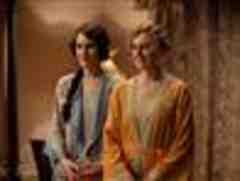Joss Barratt / Carnival Films
Michelle Dockery is Lady Mary and Laura Carmichael is Lady Edith on "Downton Abbey." The drama has spurred interest in Edwardian fashion, home furnishings and books about the era.
By Tanya Mohn, TODAY contributor
“Downton Abbey” fans may be effortlessly transported back to another time and place, but the impact of the television series is also firmly rooted in the real world. The popular costume drama has reportedly spurred sales in everything from wedding dresses, lingerie and other Edwardian fashions to home furnishings and even what people are reading.
“Etiquette books are selling through the roof right now” said Scott F. Stoddart, dean of the School of Liberal Arts at the Fashion Institute of Technology. So are history books about World War I and recently reprinted titles like “To Marry an English Lord.” “People are drawn to a bygone era, a more romantic time of gracious living,” he said.
The influence of popular culture on style and taste goes back to the early days of Hollywood, when film stars like Joan Crawford, dressed as a flapper in the 1920s and 1930s, inspired shorter hemlines. After Elizabeth Taylor appeared in “A Place in the Sun” in the early 1950s wearing a distinctive dress, “every girl wanted to wear it to the prom that year,” said Stoddart, author of “Analyzing Mad Men” and of the forthcoming “Exploring Downton Abbey” to be released during the summer of 2013.
The trend for a television series to impact the marketplace is more recent, as the medium typically influenced viewers through advertising. “To my mind, ‘Mad Men’ is one of the first,” inspiring companies like Brooks Brothers, Banana Republic and Crate & Barrel to create everything from 60s-era men’s suits to living rooms sets, said Stoddart. “It really takes about two to three seasons before retailers really get on the band wagon. It’s happening now with ‘Downton Abbey.’”
Ralph Lauren has a new collection, modeled by actress Jessica Chastain, that features Lady Mary-type turn-of-the-century hunting garb, and other "Downton"-inspired products include 1920s-era jewelry collections and T-shirts based on characters in the series.
Skinny ties made a comeback after “Mad Men,” said Stoddart, and soon “we will give gloves a nod because of 'Downton Abbey.' ”
Leonard Lee, an associate professor at the Columbia Business School, said the financial impact of popular shows is difficult to measure. But while he is not aware of any academic research or tracking of the phenomenon, the underlying psychological process is consistent with what is known about consumer behavior. Repeated exposure, positive feelings, imitating behavior, and the desire to be a part of the larger experience and enjoy it in a more proactive way, he said, are factors that typically influence spending choices.
Emotional resonance, not logic, is often key, said Lee, referring to a well-known study that analyzed how decorative posters were chosen and found that participants who deliberated more about which one to buy were less likely to hang them up. “Sometimes when you think too much about options, you tend to be more dissatisfied than when you rely more on feelings and evaluate holistically.”
The influence of popular culture on spending is growing, said Marshal Cohen, chief industry analyst of The NPD Group, a market research company, who has followed consumer behavior and retail trends for more than 30 years. “It used to be that fashion led the way for what’s in, what’s out,” he said, but today, entertainment and popular culture have taken on a larger role, though the public typically downplays it.
The NPD Group conducts a survey each year in which respondents are asked if they made purchases influenced by celebrities. “Every year consumers deny it, yet the numbers show they do it more and more,” Cohen said. A decade ago, for example, 8 percent of survey respondents said they made purchases as a direct result of celebrity influence. But in the most recent survey, conducted in March 2012, 18 percent admitted they did so. “They don’t like to admit they are easily influenced and swayed,” said Cohen, who is the author of “Why Customers Do What They Do”and “Buy Me! How to Get Customers to Choose Your Products and Ignore the Rest.”
“Fashion is easiest industry to see the cause and effect,” of popular culture, but interior design, home furnishings and other lifestyle areas are also impacted. During the recession, the fashion industry “was scared. It didn’t take chances on color and design,” resulting in safe products that lacked inspiration and bored consumers.
But the "Downton Abbey" influence is positive, for the public and the retail industry, experts say.
“It’s so different; it’s new and fresh,” said Cohen.
“Anything that expands your mind is always a good thing,” said Stoddart, whether it’s fashion or reading history. “It adds to a strong conversation between people.”







0 коммент.:
Post a Comment